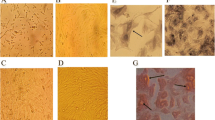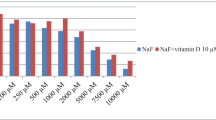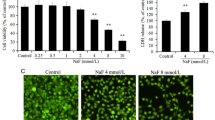Abstract
Aluminum (Al) is known to induce apoptosis of osteoblasts (OBs). However, the mechanism is not yet established. To investigate the apoptotic mechanism of OBs induced by aluminum trichloride (AlCl3), the primary OBs from the craniums of fetal Wistar rats were exposed to 0 mg/mL (control group, CG), 0.06 mg/mL (low-dose group, LG), 0.12 mg/mL (mid-dose group, MG), and 0.24 mg/mL (high-dose group, HG) AlCl3 for 24 h, respectively. We observed that AlCl3 induced OB apoptosis with the appearance of apoptotic morphology and increase of apoptosis rate. Additionally, AlCl3 treatment activated mitochondrial-mediated signaling pathway, accompanied by mitochondrial membrane potential (ΔΨm) depolarization, release of cytochrome c from the mitochondria to the cytoplasm, as well as survival signal-related factor caspase-9 and caspase-3 activation. AlCl3 exposure also activated Fas/Fas ligand signaling pathway, presented as Fas, Fas ligand, and Fas-associated death domain expression enhancement and caspase-8 activation, as well as the hydrolysis of Bid to truncated Bid, suggesting that the Fas-mediated signaling pathway might aggravate mitochondria-mediated OB apoptosis through hydrolyzing Bid. Furthermore, AlCl3 exposure inhibited Bcl-2 protein expression and increased the expressions of Bax, Bak, and Bim in varying degrees. These results indicated that AlCl3 exposure induced OB apoptosis through activating Fas- and mitochondria-mediated signaling pathway and disrupted B-cell lymphoma-2 family proteins.









Similar content being viewed by others
Abbreviations
- Al:
-
Aluminum
- AlCl3 :
-
Aluminum trichloride
- ANOVA:
-
One-way analysis of variance
- AO/EB:
-
Acridine orange/ethidium bromide
- Bcl-2:
-
B-cell lymphoma-2
- Cyt-C:
-
Cytochrome c
- DMEM:
-
Dulbecco’s minimum essential medium
- FADD:
-
Fas-associated death domain
- FasL:
-
Fas ligand
- FBS:
-
Fetal bovine serum
- JC-1:
-
5,5′,6,6′-Tetrachloro-1.1′,3,3′-tetraethylbenzimidazolylcarbocyanine iodide
- MPTP:
-
Mitochondrial permeability transition pore
- MTP:
-
Mitochondrial transmembrane potential
- OBs:
-
Osteoblasts
- qRT-PCR:
-
Quantitative real-time reverse transcription-polymerase chain reaction
- SDS-PAGE:
-
SDS-polyacrylamide gel electrophoresis
References
Krewski D, Yokel RA, Nieboer E, Borchelt D, Cohen J, Harry J, Kacew S, Lindsay J, Mahfouz AM, Rondeau V (2007) Human health risk assessment for aluminium aluminium oxide and aluminium hydroxide. J Toxic Environ Health B Crit Rev 10(Suppl 1):1–269
Crisponi G, Fanni D, Gerosa C, Nemolato S, Nurchi VM, Crespo-Alonso M, Lachowicz JI, Faa G (2013) The meaning of aluminium exposure on human health and aluminium-related diseases. Biomol Concepts 4:77–87
Yokel RA, Florence RL (2008) Aluminum bioavailability from tea infusion. Food Chem Toxicol 46:3659–3663
Fekete V, Vandevijvere S, Bolle F, Van Loco J (2013) Estimation of dietary aluminum exposure of the Belgian adult population: evaluation of contribution of food and kitchenware. Food Chem Toxicol 55:602–608
Willhite CC, Karyakina NA, Yokel RA, Yenugadhati N, Wisniewski TM, Arnold IM, Momoli F, Krewski D (2014) Systematic review of potential health risks posed by pharmaceutical occupational and consumer exposures to metallic and nanoscale aluminum aluminum oxides aluminum hydroxide and its soluble salts. Crit Rev Toxicol 44(Suppl 4):1–80
Ali A, Strezov V, Davies P, Wright I (2017) Environmental impact of coal mining and coal seam gas production on surface water quality in the Sydney basin, Australia. Environ Monit Assess 189:408
Machado CS, Fregonesi BM, Alves RIS, Tonani KAA, Sierra J, Martinis BS, Celere BS, Mari M, Schuhmacher M, Nadal M, Domingo JL, Segura-Munoz S (2017) Health risks of environmental exposure to metals and herbicides in the Pardo River, Brazil. Environ Sci Pollut Res. https://doi.org/10.1007/s11356-017-9461-z
Tidblad J, Kreislova K, Faller M, de la Fuente D, Yates T, Verney-Carron A, Grontoft T, Gordon A, Hans U (2017) ICP materials trends in corrosion, soiling and air pollution (1987–2014). Materials. https://doi.org/10.3390/ma10080969
Jiang Q, Wang J, Li M, Liang X, Dai G, Hu Z, Wen J, Huang Q, Zhang Y (2013) Dietary exposure to aluminium of urban residents from cities in South China. Food Addit Contam Part A Chem Anal Control Expo Risk Assess 30:698–704
Sato K, Suzuki I, Kubota H, Furusho N, Inoue T, Yasukouchi Y, Akiyama H (2014) Estimation of daily aluminum intake in Japan based on food consumption inspection results: impact of food additives. Food Sci Nutr 2:389–397
Priest ND (2004) The biological behaviour and bioavailability of aluminium in man with special reference to studies employing aluminium-26 as a tracer: review and study update. J Environ Monit 6:375–403
Krewski D (2014) Systematic review of potential health risks posed by pharmaceutical occupational and consumer exposures to metallic and nanoscale aluminum aluminum oxides aluminum hydroxide and its soluble salts. Crit Rev Toxicol 44(Suppl 4):1–80
Malluche HH (2002) Aluminium and bone disease in chronic renal failure. Nephrol Dial Transplant 17(Suppl 2):21–24
Li X, Hu C, Zhu Y, Sun H, Li Y, Zhang Z (2011) Effects of aluminum exposure on bone mineral density mineral and trace elements in rats. Biol Trace Elem Res 143:378–385
Cournot-Witmer G, Zingraff J, Plachot JJ, Escaig F, Lefevre R, Boumati P, Bourdeau A, Garabedian M, Galle P, Bourdon R, Drueke T, Balsan S (1981) Aluminum localization in bone from hemodialyzed patients: relationship to matrix mineralization. Kidney Int 20:375–378
Jablonski G, Klem KH, Danielsen CC, Mosekilde L, Gordeladze JO (1996) Aluminium-induced bone disease in uremic rats: effect of deferoxamine. Biosci Rep 16:49–63
Sun X, Cao Z, Zhang Q, Liu S, Xu F, Che J, Zhu Y, Li Y, Pan C, Liang W (2015) Aluminum trichloride impairs bone and downregulates Wnt/beta-catenin signaling pathway in young growing rats. Food Chem Toxicol 86:154–162
Zhu Y, Hu C, Zheng P, Miao L, Yan X, Li H, Wang Z, Gao B, Li Y (2016a) Ginsenoside Rb1 alleviates aluminum chloride-induced rat osteoblasts dysfunction. Toxicology 368–369:183–189
Zhu Y, Xu F, Yan X, Miao L, Li H, Hu C, Wang Z, Lian S, Feng Z, Li Y (2016b) The suppressive effects of aluminum chloride on the osteoblasts function. Environ Toxicol Pharmacol 48:125–129
Sun X, Liu J, Zhuang C, Yang X, Han Y, Shao B, Song M, Li Y, Zhu Y (2016b) Aluminum trichloride induces bone impairment through TGF-beta1/Smad signaling pathway. Toxicology 371:49–57
Harada S, Rodan GA (2003) Control of osteoblast function and regulation of bone mass. Nature 423:349–355
Yang X, Huo H, Xiu C, Song M, Han Y, Li Y, Zhu Y (2016) Inhibition of osteoblast differentiation by aluminum trichloride exposure is associated with inhibition of BMP-2/Smad pathway component expression. Food Chem Toxicol 97:120–126
Sun X, Cao Z, Zhang Q, Li M, Han L, Li Y (2016a) Aluminum trichloride inhibits osteoblast mineralization via TGF-beta1/Smad signaling pathway. Chem Biol Interact 244:9–15
Hellstrom HO, Mjoberg B, Mallmin H, Michaelsson K (2005) The aluminum content of bone increases with age but is not higher in hip fracture cases with and without dementia compared to controls. Osteoporos Int 16:1982–1988
Aaseth J, Boivin G, Andersen O (2012) Osteoporosis and trace elements—an overview. J Trace Elem Med Biol 26:149–152
Marie PJ, Kassem M (2011) Osteoblasts in osteoporosis: past emerging and future anabolic targets. Eur J Endocrinol 165:1–10
Jilka RL, O’Brien CA, Roberson PK, Bonewald LF, Weinstein RS, Manolagas SC (2014) Dysapoptosis of osteoblasts and osteocytes increases cancellous bone formation but exaggerates cortical porosity with age. J Bone Miner Res 29:103–117
Armour KJ, Armour KE, van’t Hof RJ, Reid DM, Wei XQ, Liew FY, Ralston SH (2001) Activation of the inducible nitric oxide synthase path. Arthritis Rheum 44(12):2790–2796
Bradford PG, Gerace KV, Roland RL, Chrzan BG (2010) Estrogen regulation of apoptosis in osteoblasts. Physiol Behav 99:181–185
Li X, Han Y, Guan Y, Zhang L, Bai C, Li Y (2012) Aluminum induces osteoblast apoptosis through the oxidative stress-mediated JNK signaling pathway. Biol Trace Elem Res 150:502–508
Cao Z, Liu D, Zhang Q, Sun X, Li Y (2016) Aluminum chloride induces osteoblasts apoptosis via disrupting calcium homeostasis and activating Ca(2+)/CaMKII signal pathway. Biol Trace Elem Res 169:247–253
Saikumar P, Dong Z, Mikhailov V, Denton M, Weinberg JM, Venkatachalam MA (1999) Apoptosis: definition mechanisms and relevance to disease. Am J Med 107:489–506
Liu W, Zhao H, Wang Y, Jiang C, Xia P, Gu J, Liu X, Bian J, Yuan Y, Liu Z (2014) Calcium-calmodulin signaling elicits mitochondrial dysfunction and the release of cytochrome c during cadmium-induced apoptosis in primary osteoblasts. Toxicol Lett 224:1–6
Gross A, McDonnell JM, Korsmeyer SJ (1999) BCL-2 family members and the mitochondria in apoptosis. Genes Dev 13:1899–1911
Wiren KM, Toombs AR, Semirale AA, Zhang X (2006) Osteoblast and osteocyte apoptosis associated with androgen action in bone: requirement of increased Bax/Bcl-2 ratio. Bone 38:637–651
Liang M, Russell G, Hulley PA (2008) Bim, Bak, and Bax regulate osteoblast survival. J Bone Miner Res 23:610–620
Yang D, Okamura H, Teramachi J, Haneji T (2016) Histone demethylase Jmjd3 regulates osteoblast apoptosis through targeting anti-apoptotic protein Bcl-2 and pro-apoptotic protein. Bim Biochim Biophys Acta 1863:650–659
Kilkenny C, Browne WJ, Cuthill IC, Emerson M, Altman DG (2010) Improving bioscience research reporting: the ARRIVE guidelines for reporting animal research. PLoS Biol 8:e1000412
National Research Council Committee for the Update of the Guide for the Care and Use of Laboratory Animal (2011) The National Academies Collection: reports funded by National Institutes of Health. Guide for the Care and Use of Laboratory Animals. National Academies Press (US) National Academy of Sciences, Washington (DC)
Du X, Shi Z, Peng Z, Zhao C, Zhang Y, Wang Z, Li X, Liu G, Li X (2017) Acetoacetate induces hepatocytes apoptosis by the ROS-mediated MAPKs pathway in ketotic cows. J Cell Physiol 232:3296–3308
Song Y, Li N, Gu J, Fu S, Peng Z, Zhao C, Zhang Y, Li X, Wang Z, Li X, Liu G (2016) β-Hydroxybutyrate induces bovine hepatocyte apoptosis via an ROS-p38 signaling pathway. J Dairy Sci 99:9184–9198
Sun XD, Yuan X, Chen L, Wang TT, Wang Z, Sun GQ, Li XB, Li XW, Liu GW (2017) Histamine induces bovine rumen epithelial cell inflammatory response via NF-κB pathway. Cell Physiol Biochem 42:1109–1119
Pfaffl MW (2001) A new mathematical model for relative quantification in real-time RT-PCR. Nucleic Acids Res 29:e45
Kovacic N, Grcevic D, Katavic V, Lukic IK, Grubisic V, Mihovilovic K, Cvija H, Croucher PI, Marusicb A (2010) Fas receptor is required for estrogen deficiency-induced bone loss in mice. Lab Investig 90:402–413
Bu R, Borysenko CW, Li Y, Cao L, Sabokbar A, Blair HC (2003) Expression and function of TNF-family proteins and receptors in human osteoblasts. Bone 33:760–770
Duque G, Abdaimi KE, Henderson JE, Lomri A, Kremer R (2004) Vitamin D inhibits Fas ligand-induced apoptosis in human osteoblasts by regulating components of both the mitochondrial and Fas-related pathways. Bone 35:57–64
Prakash D, Sudhandiran G (2015) Dietary flavonoid fisetin regulates aluminium chloride-induced neuronal apoptosis in cortex and hippocampus of mice brain. J Nutr Biochem 26:1527–1539
Bushinsky DA (1997) Bone disease in moderate renal failure: cause, nature and prevention. Annu Rev Med 48:167–176
M’Bemba-Meka P, Lemieux N, Chakrabarti SK (2006) Role of oxidative stress mitochondrial membrane potential and calcium homeostasis in nickel subsulfide-induced human lymphocyte death in vitro. Sci Total Environ 369:21–34
Ge R, Ma WH, Li YL, Li QS (2013) Apoptosis induced neurotoxicity of Di-n-butyl-di-(4-chlorobenzohydroxamato) Tin (IV) via mitochondria-mediated pathway in PC12 cells. Toxicol in Vitro 27:92–102
Tang CH, Chiu YC, Huang CF, Chen YW, Chen PC (2009) Arsenic induces cell apoptosis in cultured osteoblasts through endoplasmic reticulum stress. Toxicol Appl Pharmacol 241:173–181
Liu X, Kim CN, Yang J, Jemmerson R, Wang X (1996) Induction of apoptotic program in cell-free extracts: requirement for dATP and cytochrome c. Cell 86:147–157
Aly HA (2013) Aroclor 1254 induced oxidative stress and mitochondria mediated apoptosis in adult rat sperm in vitro. Environ Toxicol Pharmacol 36:274–283
Hwang JK, Min KH, Choi KH, Hwang YC, Jeong IK, Ahn KJ, Chung HY, Chang JS (2013) Bisphenol A reduces differentiation and stimulates apoptosis of osteoclasts and osteoblasts. Life Sci 93:367–372
Savory J, Rao JK, Huang Y, Letada PR, Herman MM (1999) Age-related hippocampal changes in Bcl-2:Bax ratio oxidative stress redox-active iron and apoptosis associated with aluminum-induced neurodegeneration: increased susceptibility with aging. Neurotoxicology 20:805–817
Ghribi O, Herman MM, Forbes MS, DeWitt DA, Savory J (2001) GDNF protects against aluminum-induced apoptosis in rabbits by upregulating Bcl-2 and Bcl-XL and inhibiting mitochondrial Bax translocation. Neurobiol Dis 8:764–773
Nagase Y, Iwasawa M, Akiyama T, Kadono Y, Nakamura M, Oshima Y, Yasui T, Matsumoto T, Hirose J, Nakamura H, Miyamoto T, Bouillet P, Nakamura K, Tanaka S (2009) Anti-apoptotic molecule Bcl-2 regulates the differentiation activation and survival of both osteoblasts and osteoclasts. J Biol Chem 284:36659–36669
Chittenden T, Harrington EA, O’Connor R, Flemington C, Lutz RJ, Evan GI, Guild BC (1995) Induction of apoptosis by the Bcl-2 homologue Bak. Nature 374:733–736
Kluck RM, Bossy-Wetzel E, Green DR, Newmeyer DD (1997) The release of cytochrome c from mitochondria: a primary site for Bcl-2 regulation of apoptosis. Science 275:1132–1136
Herr I, Debatin KM (2001) Cellular stress response and apoptosis in cancer therapy. Blood 98:2603–2614
Wang K, Yin XM, Chao DT, Milliman CL, Korsmeyer SJ (1996) BID: a novel BH3 domain-only death agonist. Genes Dev 10:2859–2869
Kuwana T, Mackey MR, Perkins G, Ellisman MH, Latterich M, Schneiter R, Green DR, Newmeyer DD (2002) Bid Bax and lipids cooperate to form supramolecular openings in the outer mitochondrial membrane. Cell 111:331–342
Billen LP, Shamas-Din A, Andrews DW (2008) Bid: a Bax-like BH3 protein. Oncogene 27(Suppl 1):S93–104
Kook S, Zhan X, Cleghorn WM, Benovic JL, Gurevich VV, Gurevich EV (2014) Caspase-cleaved arrestin-2 and BID cooperatively facilitate cytochrome C release and cell death. Cell Death Differ 21:172–184
Kantari C, Walczak H (2011) Caspase-8 and bid: caught in the act between death receptors and mitochondria. Biochim Biophys Acta 1813:558–563
Scaffidi C, Fulda S, Srinivasan A, Friesen C, Li F, Tomaselli KJ, Debatin KM, Krammer PH, Peter ME (1998) Two CD95 (APO-1/Fas) signaling pathways. EMBO J 17:1675–1687
Hellebrand EE, Varbiro G (2010) Development of mitochondrial permeability transition inhibitory agents: a novel drug target. Drug Discov Ther 4:54–61
Funding
The study was supported by grants from the Natural Science Foundation of Heilongjiang Province (C201425) and the National Science Foundation Project (31372496).
Author information
Authors and Affiliations
Corresponding author
Rights and permissions
About this article
Cite this article
Xu, F., Ren, L., Song, M. et al. Fas- and Mitochondria-Mediated Signaling Pathway Involved in Osteoblast Apoptosis Induced by AlCl3 . Biol Trace Elem Res 184, 173–185 (2018). https://doi.org/10.1007/s12011-017-1176-y
Received:
Accepted:
Published:
Issue Date:
DOI: https://doi.org/10.1007/s12011-017-1176-y




